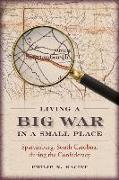- Start
- Living a Big War in a Small Place
Living a Big War in a Small Place
Angebote / Angebote:
Most of what we know about how the Civil War affected life in the Confederacy is related to cities, troop movements, battles, and prominent political, economic, or military leaders. Far less is known about the people who lived in small Southern towns remote from marching armies or battles. Philip N. Racine explores life in one such place--Spartanburg, South Carolina--in an effort to reshape the contours of that great conflict.
By 1864 life in most of the Confederacy, but especially in rural towns, was characterized by scarcity, high prices, uncertainty, fear, and bad-tempered neighbors. Shortages of food were common. People lived with constant anxiety that a soldiering father or son would be killed or wounded. Taxes were high, inflation was rampant, good news was scarce and seemed to always be followed by bad. The slave population was growing restive as their masters' bad news was their good news. Army deserters were threatening lawlessness, accusations and vindictiveness colored the atmosphere and added to the anxiety, fear, and feeling of helplessness. Often people blamed their troubles on the Confederate government in faraway Richmond, Virginia.
Racine provides insight into these events through personal stories: the plight of a slave, the struggles of a war widow managing her husband's farm, ten slaves, and seven children, and the trauma of a lowcountry refugee's having to forfeit a wealthy, aristocratic way of life and being thrust into relative poverty and an alien social world.
All were part of the complexity of wartime Spartanburg District.
Folgt in ca. 15 Arbeitstagen

